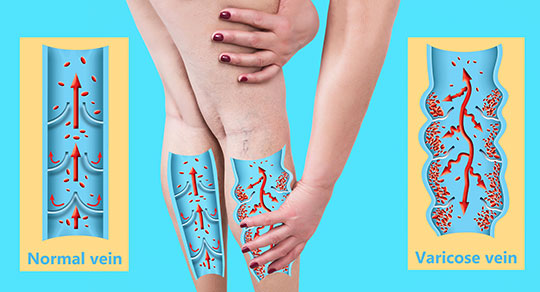Conditions & Diseases
Varicose Veins
Varicose veins occur when the vessel walls or the valves in veins stretch or weaken, allowing blood to flow back down into the legs. When too much blood flows back into the legs, the leg veins begin to show signs and symptoms.
Signs & symptoms
- Swelling, heaviness, pain or dark areas on the skin
- Cosmetically unappealing veins
- Skin ulceration in advanced cases
Risk factors
Varicose veins are a common condition for nearly half of all people over the age of 50.
Factors include:
- Gender (Women are more prone)
- Pregnancy (Some women experience this condition due to blood flow changes)
- A person who spends long periods standing
- A family history
- Obesity
- Age
Diagnosis
Varicose veins can usually be diagnosed by a simple physical examination; however, the cause of the varicose vein requires the use of Doppler ultrasound.
This painless test, which is performed in our office, assesses venous valve function in the groin, and can also determine how much blood is flowing back into the legs. The test can also determine the structure of your leg veins, as well as the presence of blood clots in the veins. This test can take between 20-30 minutes for each leg.
Treatment
Our physicians are experienced in a variety of advanced treatment options to relieve the pain and improve the appearance of your legs. Many procedures can be completed in our offices, causing minimal discomfort and shorter recovery times.
Treatment options include:
Radiofrequency Ablation (AKA Laser Vein Surgery) utilizes radiofrequency (RF) energy to destroy the diseased varicose vein which causes the vein to seal closed. This is a minimally invasive procedure performed in the physician’s office with minimal complications. A patient can return to most normal activities immediately afterward.
Sclerotherapy is performed in our office by injecting a chemical substance called a sclerosant directly into the affected veins. The chemical causes the affected veins to harden from the inside out, so they can no longer fill with blood. The veins close off and are reabsorbed by your body over a few weeks to months.
Microphlebectomy is an in-office procedure that involves the removal of varicose veins in the leg without surgery. Veins are flexible and collapse easily, and even some large veins can be removed through small nicks in the skin. Microphlebectomy is often done to complement endovenous laser ablation and radiofrequency ablation. Microphlebectomy can not only offer symptomatic relief, but also help make you feel more comfortable in the appearance of your legs.


